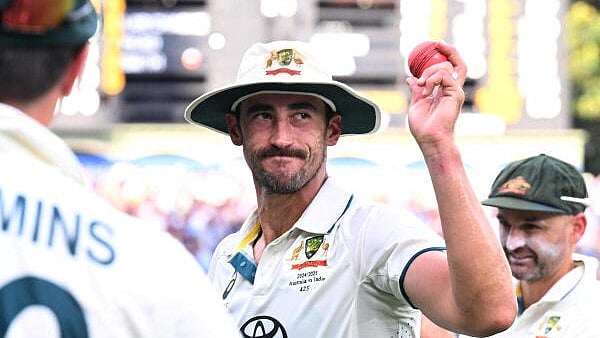
Australian's Mitchell Starc shows the ball at the change of innings after taking 5 wickets
Credit: Reuters Photo
Adelaide: One win doesn’t make a summer. Conversely, one loss doesn’t mean a trend. Truth be told, few gave India a chance to win in the first Test at the Perth Stadium, a venue where Australia had never lost and had deliberately chosen to intimidate the opposition into submission.
On India’s part, they were a disjointed group with injuries to key players and the absence of regular skipper Rohit Sharma through paternity leave, leaving them in a vulnerable spot. Through a combination of brilliant bowling all along and a more determined batting show in the second innings, they turned the table across the unsuspecting Australians. While shock and harsh evaluation stung Australia, some even insinuating division in the team based on a stray comment, paeans were written in praise of Indians.
One week later, the situation has flipped completely following Australia’s comprehensive win here on Sunday. Come to think of it, the chances of India winning a day/night Test were as good as Australia losing in Perth. And the fact that it actually came true, raised India’s hopes of winning the pink-ball contest exponentially.
Let’s face it: Australia, Adelaide and pink ball are an unbeatable combination at the moment. Pink-ball cricket is to bowlers what white-ball cricket is to batters. Both are tilted heavily towards one craft. And Australia have the best exponents of the sphere in the world. They know the lengths to bowl and they know the lines to maintain to optimise an otherwise extravagant behaviour of the ball. They targeted the stumps and pads, the best ploy with any ball and especially so with the pink-ball.
The Aussie bowlers accuracy can be illustrated through modes of most Indian batters’ dismissals. There were seven wickets either bowled or lbw, four were caught behind and six were caught in slip cordon or gully.
Bowling coach Morne Morkel conceded that Indian bowlers missed a trick or two with the pink-ball. They couldn’t, he felt, execute the plans they had drawn up prior to the match
“For me, if I can just throw in a clock to the first Test match, I thought our lines and lengths were exceptional,” he said talking about the learnings from the experience. “And I think that was sort of the blueprint for us going into this Test series. We wanted to bring the stumps into play as much as possible. And I felt last night with the ball moving around a little bit, we missed that.
“We were slightly off the mark with that in terms of finding the right sort of length. And at times we were touch wide. So we allowed the guys to leave a lot of balls, which sort of history of looking at the pink ball that time of night, if you bowl, that’s where you can pick up your wickets,” he reasoned.
Australia have played the most number of pink-ball Tests and, naturally, they have batters who are better-equipped to score off and bowlers who have enviable records. The top four bowlers with most wickets in day/night Tests are Mitchell Starc (74), Nathan Lyon (43), Pat Cummins (41) and Josh Hazlewood (37) and top four batters are Marnus Labuschagne (958), Steve Smith (762), David Warner (753), Travis Head (683) and Usman Khawaja (538).
It’s an unequal contest at the moment, and while India could eventually get there with more exposure to day/night Tests, for now, judge them by their red-ball standards. And that challenge resumes with the third Test Brisbane.
Did someone say ‘can’t wait to get you at the Gabba?!’